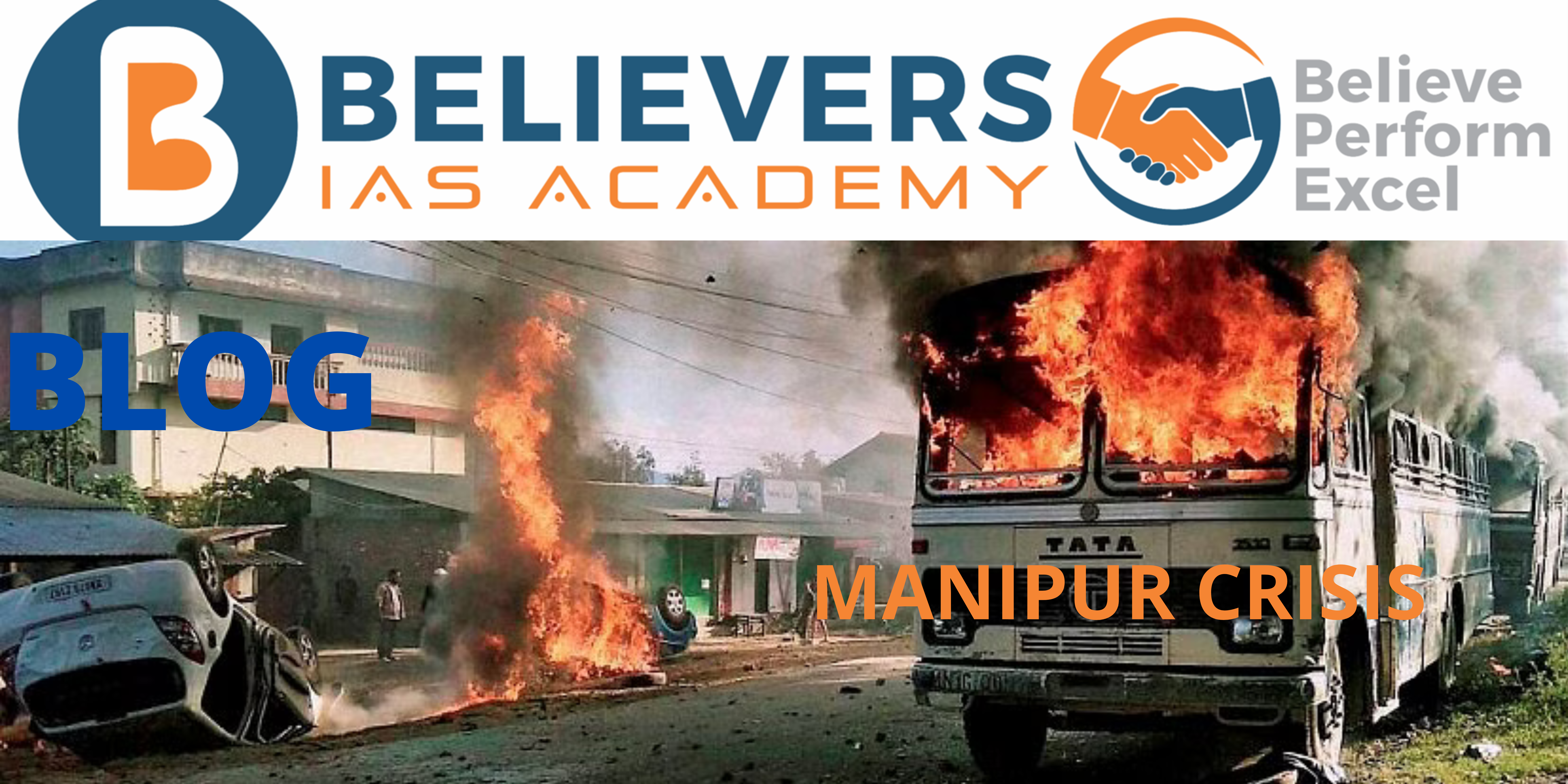Manipur Crisis
About Manipur
- Manipur is a state in northeastern India, bordered by Nagaland to the north, Mizoram to the south, and Assam to the west.
- The capital of Manipur is Imphal, which is also the largest city in the state.
- Manipur is known for its natural beauty, with hills, valleys, and forests covering much of the state. The Loktak Lake, which is the largest freshwater lake in northeastern India, is also located in Manipur.
- The people of Manipur are predominantly of the Meitei ethnic group, but there are also several other ethnic communities in the state, including the Nagas and Kukis.
- Manipur has a rich cultural heritage, with traditional dance forms such as the Manipuri dance and the Thang-Ta martial art being popular in the state.
- The economy of Manipur is primarily based on agriculture and forestry, with rice being the main crop grown in the state. Handloom and handicrafts are also important industries in Manipur.
- Manipur has faced several challenges over the years, including conflicts between various ethnic groups and separatist movements. The state has also been affected by natural disasters such as earthquakes and floods.
- In recent years, the government of Manipur has taken steps to promote tourism in the state, with a focus on eco-tourism and adventure sports. The state has also made efforts to improve infrastructure and attract investment in various sectors.
Recent Context:
The communal violence between the Kukis and Meiteis that broke out in several townships in Manipur is now mostly under control, but the situation is still tense and volatile because many people have been displaced from their homes and are seeking refuge in relief camps on the campuses of police and paramilitary institutions.
Ethnic Composition of Manipur
- Meitei: The majority ethnic group in the northeastern Indian state of Manipur is the Meitei. They communicate in Meitei, one of India’s 22 official languages and also known as Manipuri.
- Although a sizeable population of Meitei people have settled in neighbouring Indian states including Assam, Tripura, Nagaland, Meghalaya, and Mizoram, their main home is the Imphal Valley region of Manipur.
- Not only in India but also in the neighbouring countries of Bangladesh and Myanmar, Meitei people are particularly prevalent.
- Meitei makes up about 53% of Manipur’s population. The Meitei people are highly renowned in India for their traditional styles of dance, music, and art. They have a rich cultural heritage.
- The Meitei people have had political and social challenges lately, including disagreements with the Indian government on issues like autonomy and land rights.
- Naga: This ethnic group is mostly found in the hills of Manipur, Nagaland, and other Northeast Indian states. They are renowned for their traditional clothes and distinctive manner of life and have a distinct culture and language.
- Kuki: Native to northeastern India, the Kuki people are mainly found in the hills of Manipur, Mizoram, and other states. They are noted for their rich cultural legacy and speak their language, which is a member of the Tibeto-Burman language family.
- Hmar: The Hmar people are an indigenous group that is mostly found in the mountains of Assam, Mizoram, and Manipur. They speak a language that is a member of the Kukish language family, and they are well-known for their folk music and dances.
- Paite: A group of indigenous people who are mostly found in the mountains of Manipur and Mizoram. They speak a language that is a member of the Kuki-Chin language family and are well known for their handicrafts and traditional weaving.
- Thadou: The Thadou are an indigenous group that is mostly found in the mountains of Assam, Mizoram, and Manipur. They speak a language that is a member of the Kuki-Chin linguistic family and is well-known for their devotion to music and old-fashioned farming methods.
These are only a few of the numerous ethnic groups, each with their own distinctive culture, traditions, and way of life, that make up the population of Manipur.
Background of the issue:
- Northeastern Indian hill state Manipur is bordered to the east and south by Myanmar.
- The Imphal Valley, which makes up around 10% of the state’s total area, is the most populous region in Manipur. Most of the Meitei people in this valley are Hindu, and they make up a sizeable section of the population.
- Numerous hill tribes live in the hills surrounding Manipur. The Kukis predominately live in the southern section, while the Nagas live in the northeastern region.
- The Land Reform Act of Manipur forbids the Meiteis, who make up 53% of the population, from living in the hilly areas of the state.
- About 40% of Manipur’s population is tribal, primarily made up of Christian Kukis and Nagas. They are concentrated in the state’s reserved hill regions, which make up the remaining 90% of the land.
- The Land Reform Act prohibits Meiteis from settling in the hills while allowing tribal people to do so in the valley zone.
- The Meiteis control politics in the Manipur Legislative Assembly. Out of the Assembly’s 60 seats, 19 are set aside for representation of Scheduled Tribes (ST), especially Naga or Kuki.
- The remaining 40 seats are in unreserved general constituencies, and 39 of these seats went to Meitei candidates in the most recent election.
- Tribal organisations have expressed worry that the hill regions are being neglected and underdeveloped as a result of the government’s excessive attention on the Meitei-dominated Imphal Valley.
- Manipur has seen tension and unrest as a result of the unequal allocation of political power and government resources between the Meiteis in the valley and the tribal communities in the hills.
Present scenario
- Immigration without authorization: The Manipur state government started making efforts to evict illegal residents from colonies in reserve forest regions. According to reports, Manipur has been home to illegal immigrants from Myanmar since the 1970s.
- Tribal Concerns: Tribal organisations voiced worry that the government’s efforts to stop illegal immigration would be used as a cover by the Meitei people to evict the tribal population from their homes. They viewed the campaign of expulsion as anti-tribal.
- Eviction effort: In the districts of Churachandpur, Kangpokpi, and Tengnoupal, the BJP state government launched an eviction effort in February 2023. Tensions between the government and tribal groups increased after forest inhabitants were labelled as encroachers.
- Suspension of Operation Ceasefire Agreements: In March, the Manipur Cabinet withdrew from agreements with the Kuki National Army and the Zomi Revolutionary Army about the suspension of operations. The security situation in the area was impacted by this activity.
- National Register of Citizens (NRC) demand: Manipuri organisations held a protest in New Delhi to call for the establishment of an NRC with 1951 as the starting year. They bemoaned the unnatural increase of the population in the hilly areas.
- Violence: At a protest against the alleged encroachment of tribal land under the pretext of reserved forests, protected forests, and wildlife sanctuaries, violence occurred when fighting broke out in the Kangpokpi area. This incident resulted in five injuries.
- Church Demolitions: In April, three churches in Imphal’s Tribal Colony locality were razed by the government on the grounds of being “illegal constructions” on government land.
- Meitei Community’s ST Status: A judge of the Manipur High Court directed the state government to consider the request of the Meitei community to be included in the Scheduled Tribes (ST) list. This decision raised concerns among the Kuki community, as they feared it would enable the Meiteis to purchase land in prohibited hilly areas.
Way Forward
-
- Facilitate conversation and reconciliation between various parties, including the government, local communities, civil society organisations, and rebel groups. A calm and inclusive dialogue approach can foster mutual respect and understanding as well as open the door to rapprochement.
- Disparities in socioeconomic status, including underdevelopment, unemployment, and insufficient access to essential services, are at the basis of many conflicts in Manipur. Infrastructure, education, healthcare, and skill advancement are all areas where investing can help reduce inequalities and provide individuals more chances.
- Encourage multiculturalism and inclusion: Manipur is home to a variety of communities, each with its distinct traditions and identities. Promoting inclusion, tolerance, and cultural understanding can help heal rifts and strengthen bonds between various communities.
- Strengthen law enforcement and governance: Increase the ability of law enforcement organisations to uphold regional peace and security. Addressing corruption, enhancing the justice system, and ensuring the rule of law are some of these. Restoring public confidence can also be aided by strengthening governance frameworks and fostering accountability and openness.
- Empower local communities by including them in decision-making processes and giving them the tools they need to actively engage in determining their destiny. Local issues can be addressed and complaints decreased by promoting community-based activities, assisting neighbourhood development initiatives, and ensuring representation in governance institutions.
- Manipur collaborates with neighbouring nations and states along its shared borders. Increasing regional collaboration and communication can aid in resolving international problems, advance economic and trade integration, and improve security cooperation
- Empower local communities by including them in decision-making processes and giving them the tools they need to actively engage in determining their destiny. Local issues can be addressed and complaints decreased by promoting community-based activities, assisting neighbourhood development initiatives, and ensuring representation in governance institutions.
- Manipur collaborates with neighbouring nations and states along its shared borders. Increasing regional collaboration and communication can aid in resolving international problems, advance economic and trade integration, and improve security cooperation.





